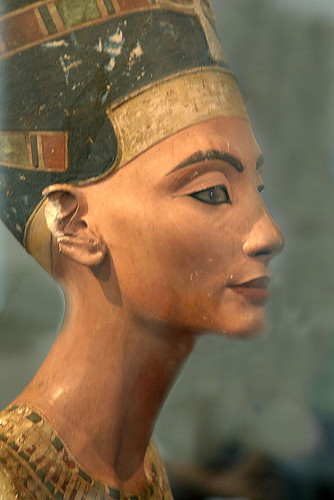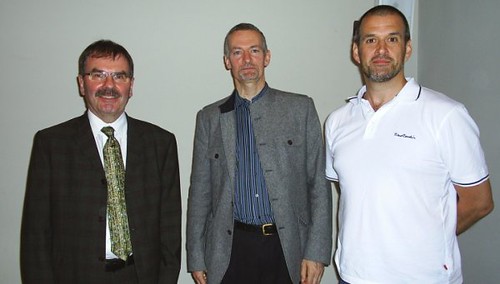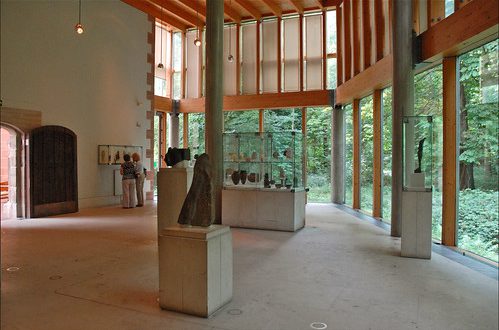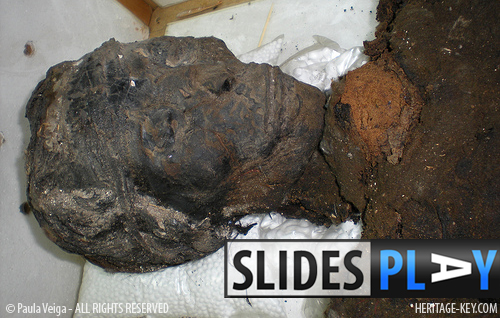Following all the doubt and controversy surrounding claims that the Bust of Nefertiti is a fake, I would like to present my case and say why I believe the bust, now housed in the Neues Museum in Berlin, is an original.
Let’s go back and look at the evidence, starting with a 2008 article in KMT magazine named ‘Why Nefertiti Went to Berlin’ written by Dr Rolf Krauss. The article includes some important transcripts and images. One photo shows Egyptologists looking at the bust of Nefertiti, held by an Egyptian workman, captioned: ‘The first presentation of the bust of Nefertiti following its discovery on December 6, 1912’.
On the next page it is stated that:
The excavation was paid for by James Simon, treasurer of the German Oriental Society, (DOG) with his own money. (…) He first loaned and then donated all of these objects to the Berlin Egyptian Museum in 1920;
El Amarna was under the authority of the Antiquities Inspectorate in Asyut, and the inspector there was Gustave Lefebvre (…) it thus fell to Lefebvre to divide the El Amarna finds.
The article goes on to quote from a letter from Bruno Gueterbock (secretary of DOG) to Guenther Roeder, (director Roemer-Pelizaeus Museum):
You can imagine that we all had very little hope that this wonderful piece would not go to Cairo, so little,that on the evening before Lefebvre’s arrival all the inhabitants of the excavation house walked in solemn procession, candle in hand, to the storeroom to bid our farewell to the colourful Queen.
Importantly, the article goes on to mention that when questioned a decade later, Lefebvre said he could not remember whether he had seen the bust or not. Stranger and stranger.
Why Does This Suggest That the Bust Isn’t Fake?
- The bust was found in 1912 by Ludwig Borchardt and the occasion photographed
- It did not look exactly like it does now at the Neues Museum, as it was still unclean
- Lefebvre had to send the piece somewhere, and the piece did not stay in Cairo.
In May this year, Dietrich Wildung, curator of the Berlin’s Egyptian Museum, responded to accusations that the Bust of Nefertiti is a fake in Der Spiegel, saying: “We would not put an even remotely questionable object on display for 700,000 visitors to see every year.
Also, if the Nefertiti bust was a fake I am sure Dr. Hawass would not want it back in Egypt so much…
The Proof is in the CT Scan
Trying to scientifically prove if this piece is a fake we might take into consideration a CT scan carried out this year by researchers in Germany using a modern medical procedure to uncover the two faces of Nefertiti.
The hidden face differs slightly from the model we see, with creases at the corners of the mouth, and a bump on the nose of the inner stone version(meaning that Nefertiti lookalike Nileen Namita got it wrong).
Dr. Alexander Huppertz suggested that someone expressly ordered that these adjustments be made between the stone and the stucco versions in an article published in the April issue of Radiology. Pictures form the scanned images explain how afirst CT investigation was done in 1992, which was followedby a second in 2006, both intending to clarify the technology of fabrication. Siemens, together with Professor Dietrich Wildung, and the National Geographic Channel have scanned the bust for an investigation conducted for a National Geographic documentary.
The results, provided by the Siemens computer tomography (CT) system SOMATOM Sensation 64, display a different picture of the former Egyptian queen, in which she has a very different nose. In the National Geographic article Huppertz states:
CT [scans] impressively demonstrated that the inner core was not just an anonymous mold, but rather a skillfully rendered work of quality art… In the final stucco layer, Thutmose (the sculptor) smoothed over the creases and nose bump, possibly to reflect the “aesthetic ideals of the era.”
Going back to my ‘case’, if the sculptor did a bust almost identical to the real person in the core and then covered it with layers to adjust reality to art, and this is shown by the recent scans, we have to conclude that he has a real model, thus, the piece is an original.
Take Talatat!
Another scientific study compared the pigments present in the bust to those of contemporary architecture blocks – called talatats (such as the bricks found in the dismantled temple erected by Akhenaton in Karnak). The pigments were found to be identical, adding further proof to my case that the bust must have been made in the Amarna period of Egypt.
It is too fragile to travel, and maybe that is the main reason why it is not being loaned to Egypt as requested by Dr Zahi Hawass. But it is also a key treasure for the Neues Museum in Berlin, and one that they would be reluctant to lose. As science developments are swift nowadays, we can hope for more tests to be done that will prove that this is a real object from ancient Egypt.
“We acquired a lot of information on how the bust was manufactured more than 3,300 years ago by the royal sculptor,” said Huppertz, after the recent scanning. If a scientist is convinced the bust is real, I am too.





